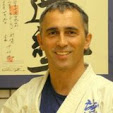
Senpai Tony and Caren
 Your House Is On Fire
Your House Is On FireHow do we really come to the decisions that we make? Is it just flip a coin and hope for the best or is there some underlying procedure that we go through, consciously or unconsciously, that guides our course of action?
Gary Klein is the author of
"Sources of Power: Real Life Decision Making." The book is somewhat technical, but the author uses examples from first responders like fire departments and medical emergency units to investigate how people make decisions, sometimes under enormously stressful circumstances. After countless interviews and case studies in the field, Mr. Klein concluded that there are two reliable pillars available to support any decision we make:
(1) pattern-matching (intuition) and
(2) mental simulation (visualization).
Coming in a close third in the toolbox of decision making was the ability to tell stories which consolidate our experiences in order to make those experiences available to ourselves (and others) in the future.
An example of how intuition comes to our aid comes from a fireman who tells the story of how, upon entering a house on fire, he had this strange feeling that something was wrong. He couldn't figure it out but something in him advised that he withdraw his team from the house immediately. Of course, seconds after his team had evacuated the structure the floor he'd been standing on exploded into flame and collapsed. It was only in retrospect that the fireman was able to understand what had happened. Fires, he said, are generally very noisy creatures. He hadn't been able to identify it at the time, but the house he and his team had entered had been uncharacteristically quiet. The fire raging unseen in the basement of the house had been muffled by the floorboards. Hence, the silence and the threat.
Its hard to consciously pick up on
something that's not there. Unconsciously though, the fireman's mind had noticed a flaw in the pattern that fires generally create and threw up a caution signal. Through his years of experience the fireman had come to trust these mysterious signals arising from his unconscious awareness, and it was the combination of experience and trust in his own awareness that saved his and his team's life that day.
The larger point of the story of the fireman is that the sources of power needed for making sound decisions are usually not analytical at all. Experience creates a set of reasonable expectations, but analysis is often absent from the moment-to-moment decision-making process. Instead we rely on intuition and visualization.
Mental simulation (visualization) draws upon our experience and allows us to imagine how a course of action might be carried out in situations that are completely new to us. Think of the Apollo 13 spacecraft and its crew. They had trained for almost every conceivable event during their flight to the moon, but they never specifically trained for the catastrophic failure that befell them on their mission. What saved them, among many things, was the ability to make accurate models of the steps they needed to take in order to survive. They were able to visualize something they’d never actually done before.
In
Seido we do something similar to the firemen and the astronauts (besides wearing odd clothing on the job). What’s the similarity? We all train. We repeat and repeat and repeat simple, basic movements. We simulate conditions for common, predictable attacks and we learn simple but effective action sequences to evade or squash those attacks.
This is all well and good, but it’s not enough for the reality of life. Life is unpredictable. Who knows what the future holds? The point of training is not to insure robotic response-ability. Rather, it’s to prepare us to act with confidence and competence in the event of something completely unexpected.
How, you might ask, does the mind-numbing and muscle-busting repetition of certain simple movements prepare us for the unexpected? The simple answer is that the high level of repetitions we perform in class act on our brain as well as our body. Scientific studies have shown that repetitive motion induces a state of awareness that gives us access to the contents of our consciousness that the rational mind usually filters out. This may account for the high number of insights and discoveries made by people when they’re washing their car, taking their dog for a walk or engaging in otherwise uncomplicated, routine actions.
A similar insight was arrived at by non-scientific means thousands of years ago and provides the rational basis for meditation. Through meditation, the moving meditation of karate, we’re able to plug into a wider awareness of life, one not limited by our self-imposed constraints. So when you come to class and embark for the hundredth time on
kihon waza (basic practice) allow for the possibility that you’re also training your capacity to discern something you can’t see, to sense the silent fire burning within you.




